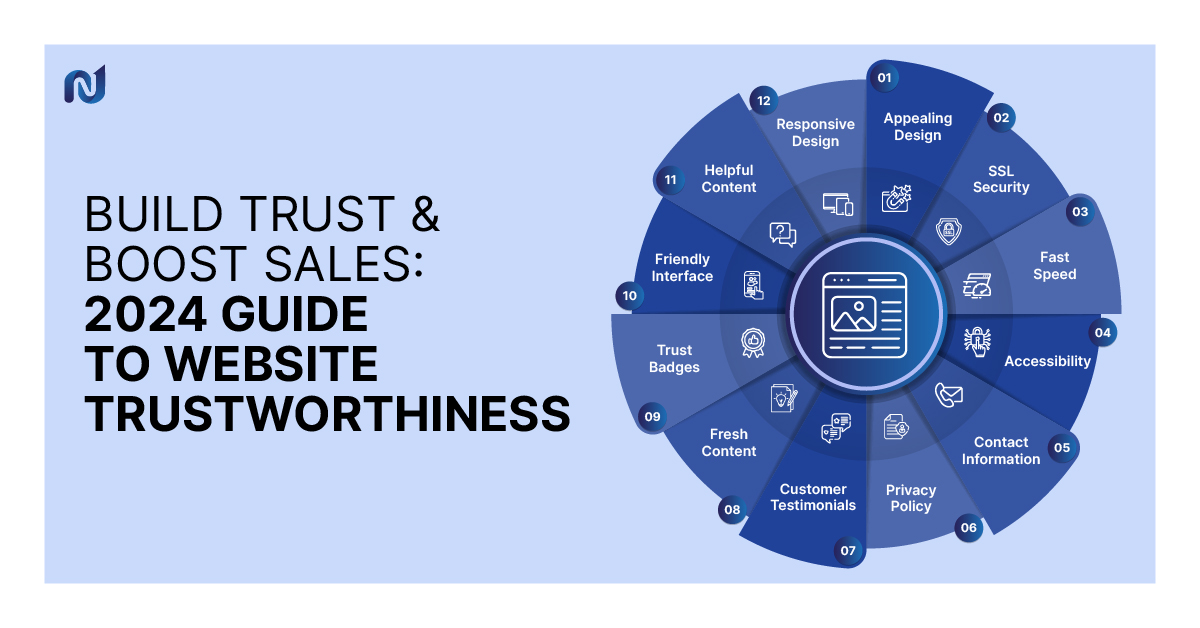
In today’s online landscape, your brand’s trustworthiness is the key to unlocking sales and growth. For businesses of all sizes, crafting a website that inspires confidence is no longer optional—it’s crucial for attracting and retaining customers. Remember, as we navigate 2024, your website isn’t just a digital storefront; it’s a powerful tool that can sway customer decisions and drive conversions.
Beyond attracting customers, website trust also sends a positive signal to search engines. Yes, trust factors heavily into SEO! A trustworthy site ranks higher, attracts more traffic, and converts visitors into buyers more effectively.
So, how do you build a web presence that earns the trust of both customers and search engines? This guide provides simple, actionable strategies to elevate your website’s trust factor, enhance your brand’s online reputation, and pave the way for sustainable growth.
Table of Contents
- The Evolving Landscape of Online Trust
- How to Create a Trustworthy Website and Build Trust with Your Brand
- Professional Website Design and User-Friendly Interface
- Clear and Accessible Contact Information (NAP)
- The “Who,” “What,” and “Why”
- Accessibility (WCAG Compliance)
- Content Focused on User Intent and Value Proposition
- Content Freshness and Topical Authority
- User-Centric SEO Optimization
- Social Proof and Engagement
- Community Management
- Credentials and Credibility
- Data Security and Encryption
- Trust Signals and Transparency
- Monitoring and Managing Your Online Reputation
- Actionable Steps to Build Trust: A Marathon, Not a Sprint
- Conclusion: Building Trust, Building Success
- FAQs
The Evolving Landscape of Online Trust: Why It Matters More Than Ever
Today, first impressions of your website determine your brand’s fate. Consumers form instant opinions, and trust is no longer a luxury, but a necessity. Savvy online users actively seek validation and assurance before buying, making trust a competitive differentiator.
With increased online threats, users prioritize website security, clear practices, and genuine brand stories. 90% of consumers trust and purchase from brands they perceive as trustworthy.
Therefore, building trust isn’t an option; it’s essential.
By creating a secure, transparent, and authentic website, you unlock the full potential of your online presence, boosting conversions, loyalty, and becoming the trusted choice for customers.
How to Create a Trustworthy Website and Build Trust with Your Brand
Think of your website as the digital front door to your business, welcoming customers and building trust. It’s often the first impression, and just like a physical storefront, needs to be visually appealing and accessible to everyone.
On top of that, your website’s content plays a crucial role in establishing trust and meeting Google’s Experience, Expertise, Authoritativeness, and Trustworthiness (EEAT) guidelines, as does your community engagement and brand reputation.
Let’s explore some key elements that foster trust:
Professional Website Design and User-Friendly Interface
- Visually Appealing Design: Invest in a website that reflects your brand identity and resonates with your target audience. This enhances user engagement and dwell time, positively impacting SEO metrics.
- Intuitive Navigation: Prioritize ease of use with clear menus, logical layouts, and consistent design elements. This improves user experience (UX), a crucial factor in Google’s EEAT (Experience, Expertise, Authoritativeness, and Trustworthiness) guidelines.
- Responsive Design: Ensure the site adapts flawlessly to various devices (desktop, mobile, tablet) for an optimal user experience (UX) across all platforms. This caters to the mobile-first indexing approach favoured by Google and boosts search ranking potential.
- Fast Loading Times: Prioritize page speed optimization to ensure your website loads quickly and keeps visitors engaged, boosting both user experience and search engine ranking.
Clear and Accessible Contact Information (NAP)
- Display NAP Clearly: Make it easy for potential and existing customers to reach you. Display your Name, Address, and Phone number (NAP) prominently on your website, preferably in the header, footer, and a dedicated Contact Us page.
- Include All Contact Info: Consider including other relevant contact options like email addresses, social media links, or live chat functionality, depending on your business type and target audience.
The “Who,” “What,” and “Why”
- Include an About Us Page: Create an informative “About Us” section that tells your story, highlights your values, and explains what makes your company unique.
- Introduce Your Team Members: Include photos, names, titles, and brief descriptions of their expertise and experience. This personalizes your brand and helps build trust with potential customers.
Accessibility (WCAG Compliance)
- Commitment to Inclusivity: Go beyond the minimum and strive for Web Content Accessibility Guidelines (WCAG) compliance, which sets international standards for making digital content accessible to everyone, including people with disabilities. This not only demonstrates social responsibility but also broadens your reach to a wider audience, potentially improving organic traffic.
- Implement Accessibility Features: Implement accessibility features such as screen reader compatibility, keyboard navigation, high-contrast themes, and descriptive alt texts.
Content Focused on User Intent and Value Proposition
- High-Quality Content: Craft engaging, informative, and search-intent-optimized content that addresses user needs and search queries.
- Expertise and Value Proposition: Showcase your brand’s expertise by positioning yourself as a thought leader in your industry. Deliver your unique value proposition by demonstrating how your products or services solve customer problems and provide clear benefits.
- Experience: Highlight your team’s experience and achievements relevant to your industry and target audience. Share success stories, case studies, or client testimonials to demonstrate your expertise and build trust.
Content Freshness and Topical Authority
- Regular Blog Posts and Updates: Maintain website freshness and establish topical authority by consistently publishing high-quality, informative blog posts aligned with your industry and user interests.
- Content Currency: Ensure content remains up to date and relevant to keep search engines and users engaged.
User-Centric SEO Optimization
- Keyword Research and Targeting: Research relevant keywords that users search for within your niche and strategically integrate them into your content while maintaining natural readability.
- Site Structure and Navigation: Optimize your website’s information architecture with a clear and user-friendly structure. This promotes easy navigation and improves both user experience and search engine crawlability.
- Informative FAQ Pages: Develop a comprehensive FAQ section addressing potential customer questions and concerns. This transparency and customer-centric approach demonstrate your brand’s commitment to user experience.
Social Proof and Engagement
- Customer Reviews and Testimonials: Leverage genuine feedback from satisfied customers through on-page reviews, testimonials, and case studies. This serves as social proof, building trust and influencing user decisions.
- Community Building: Create dedicated spaces (online forum, social media group) for customers to connect and engage with your brand and each other. This fosters a sense of belonging and loyalty while amplifying brand advocacy.
- User-Generated Content (UGC): Encourage customer interactions, reviews, and social shares to build social proof, leveraging the collective voice of satisfied customers.
- Live Social Feeds: Integrate curated social media feeds to showcase community engagement and add a sense of vibrancy to your website.
Community Management
- Active Social Media Presence: Maintain a consistent and engaging presence on social media platforms. Share valuable content, participate in conversations, and humanize your brand to build deeper connections with your audience. Respond promptly to comments and concerns received on your website, social media, or other third-party assets.
- Responsive Customer Service: Offer multiple support channels (phone, email, live chat) and ensure prompt, efficient assistance. Timely and empathetic responses to inquiries and concerns significantly improve customer satisfaction and trust.
Credentials and Credibility
- Awards and Certifications: Display prominent industry awards and recognized certifications to signal expertise and trustworthiness.
- Media Mentions: Feature positive press coverage strategically to establish credibility through third-party validation.
Data Security and Encryption
- HTTPS Implementation: Implement HTTPS (Hypertext Transfer Protocol Secure) to encrypt data transmission and protect user information, establishing a secure connection.
- Data Protection: Adhere to rigorous data protection standards and comply with relevant privacy regulations (e.g., GDPR, CCPA) to demonstrate your commitment to user privacy and data security.
Trust Signals and Transparency
- Trust Seals and Badges: Strategically incorporate recognized trust seals and badges to visually reassure visitors of your commitment to security but avoid overwhelming your website with too many.
- Transparency: Clearly communicate your security measures and data protection policies to build trust and transparency with your audience.
Monitoring and Managing Your Online Reputation
- Review Management: Actively monitor and engage with online reviews and ratings, responding constructively to both positive and negative feedback. Demonstrating responsiveness and addressing concerns directly contributes to your online reputation.
- Analytics and User Journey Optimization: Regularly analyze website traffic, user engagement, and conversion metrics using tools like Google Analytics. Understand user behaviour to identify areas for improvement and optimize the user journey for enhanced trust and satisfaction.
- User Feedback and Surveys: Directly solicit feedback from website visitors through surveys or polls. Their insights can reveal valuable details about user perception and areas for improvement, informing your website development and trust-building strategies.
- Data-Driven Decision Making: Utilize the gathered data to make informed, data-driven decisions that optimize user experience and continually evolve your website. A proactive and analytical approach ensures your digital storefront remains competitive and fosters trust with your audience.
Actionable Steps to Build Trust: A Marathon, Not a Sprint
Building trust online takes time and effort, but even small steps can lead to big improvements. Here are some actionable steps you can take to build trust with your brand online:
Start with Quick Wins: Implement HTTPS, add security badges, and display positive testimonials. You can also optimize your website’s loading speed and ensure your website loads quickly on all devices.
Embrace Long-Term Strategies: Create high-quality content, offer valuable information that positions you as an expert, and cultivate a community that fosters interaction and engagement with your audience.
Continuously Improve: Analyze data, gather feedback, and refine your website based on insights.
Conclusion: Building Trust, Building Success
In today’s digital landscape, trust is no longer a luxury—it’s the cornerstone of online success. By implementing the actionable strategies outlined in this guide, you can cultivate a secure, transparent, and engaging online presence that fosters trust, attracts customers, and drives long-term growth for your brand.
Ready to build a website that inspires trust and ignites sales? Numero Uno Web Solutions is a team of passionate SEO and web development experts dedicated to helping businesses like yours achieve their full digital potential. We offer comprehensive website development, SEO optimization, and trust-building solutions tailored to your unique needs and goals.
Contact us today for a free consultation and discover how we can help you build a website that wins hearts, minds, and conversions. Remember, a trustworthy website is an investment that pays off in customer loyalty, brand reputation, and ultimately, sustainable business success.
FAQs
What can I do to improve the trustworthiness of my website quickly?
Quick wins include adding trust seals, enhancing your site’s privacy policy, and featuring clear and accessible contact information. These interventions provide immediate signals of trust for your visitors and can swiftly enhance their confidence in your website.
Which trust badges are the most recognized and effective?
There is no one-size-fits-all solution when it comes to trust badges, as effectiveness can be influenced by industry and customer base. However, commonly recognized trust badges include SSL, PCI compliance, and TRUSTe.
What role does website speed play in building trust with users?
Website speed is crucial for trust. A fast site shows you’re reliable and value user time, making visitors more likely to trust and use your services.




